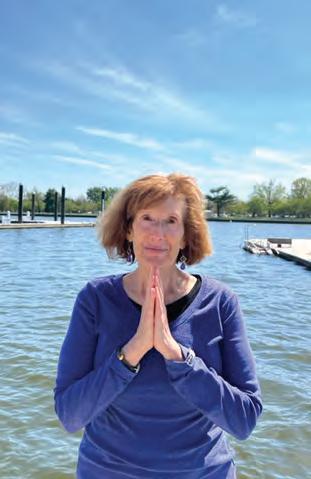
4 minute read
Yoga Nidra – A Natural Way to Relax, Rejuvenate
YOGA NIDRA
A Natural Way to Relax, Rejuvenate and Restore
Sleep is the most important healing modality for me. It comes easily and until, recently, I never woke up during the night. Now, even though those nights are few, when they occur, no matter what time it is, I have di culty falling back to sleep. Instead of lying awake, trying all sorts of techniques to clear my mind, I practice Yoga Nidra.
It’s not like any yoga class you’ve taken in a gym or a studio. The best part of an hour-long class is that you can feel like you’ve taken a four-hour nap. “One hour of Yoga Nidra is said to be the equivalent to four hours of regular sleep,” said Pamela Wilson, a yoga instructor who has been teaching for 35 years. “While sleep gives the physical and conscious mind much-needed rest, it does not rejuvenate our inner selves, the subconscious or the psychic or spiritual aspects of our beings.”
In Yoga Nidra, you remain alert in a kind of psychic sleep, following the voice of the instructor who guides you to a state of genuine relaxation that promotes well-being and mental health, and can lead to a higher level of self-realization. I have found a ton of YouTube videos (or audios) some of which use singing bowls that I can use in the middle of the night upon awakening. I even printed a script that I can record and play when I want to practice. Yoga Nidra is not like meditation, although there are some intersections between the two. Trying to meditate when I awoke in the middle of the night didn’t work for me. My mind raced and wandered until dawn.
Background and Benefits
The practice of Yoga Nidra, which can trace its roots back to India, has been studied across continents and it is backed by science. It’s proven to reduce stress and anxiety more e ectively that meditation according to a 2018 study published in the International Journal of Yoga. The practice was also found to shift the balance of our autonomic nervous system toward the parasympathetic nervous system which is what governs our relaxation response. A recent issue of Spirituality & Health magazine devoted an article to how Yoga Nidra a ects brain chemistry. It states that, according to studies, Yoga Nidra affects the production of hormones and neurotransmitters in our brain and bodies.
The potential bene ts are numerous. Some such as an improved functioning of the immune system, lower blood pressure, slower heart rate, improved circulation, pain reduction, reduced in ammation, more stable blood sugar, and an improved sense of well-being are from just a few sessions. Other conditions may improve from a consistent Yoga Nidra practice that include metabolic disease such as type 2 diabetes, psychological conditions including anxiety and depression and chronic and autoimmune diseases.
Who is Yoga Nidra for?
Yoga Nidra is for everyone. “I have people in their 80s practicing as well as a 19-year-old,” said Wilson. “I know a yoga teacher and chiropractor who designed a yoga nidra for himself to heal his autoimmune disease.” No experience with yoga is necessary.
The practice is done lying in a supine position (on your back) or substitute sivasana at the end of a yoga practice. It can be practiced at any time of the day and with any intention from falling asleep to regaining clarity.
You can set your own intention with Yoga Nidra. “The seed you sow is imbedded in the subconscious, then you water the seed which grows as a plant in your life,” Wilson explained. “For example, an intention can be, ‘I will regain my health or, I will ful ll my artistic ambition.’ Something you really want. When you go into deep relaxation you are very open.” Wilson said during Yoga Nidra you go through five levels: the physical, breath/energy, emotional/mental, higher mind/intuition and bliss. Each is a doorway to the next level allowing us to exist as our true selves. This is where a powerful healing can occur. “We are going deep. Setting an intention may lead you to make changes in your life.” Yoga Nidra is among the deepest possible states of relaxation while remaining fully conscious. You can tap into your own source of intuition, health and creativity with Yoga Nidra. Each session o ers a unique personal journey.
Wilson teaches Yoga Nidra on the third Sunday every month at St. Mark’s Episcopal Church. St. Mark’s, which is the oldest continuously running yoga center in DC, has been o ering yoga classes since the mid-1970s. She also teaches Yoga Nidra once a week as part of a chair yoga class on zoom with about 40 minutes of Yoga Nidra. The rst half of the class includes a joint-freeing series, then mild lifting, standing poses and yoga nidra or deep relaxation.
For more information contact Pamela Wilson at: wilsonpjl08@gmail.com.
by Pattie Cinelli
Yoga Nidra Instructor Pamela Wilson
Pattie Cinelli is a yoga teacher, health and tness professional and journalist who has been writing her column for more than 25 years. She focuses on holistic and non-mainstream ways to stay healthy, get well and connect with your true self. Please email her with questions, comments or column suggestions at: tmiss44@ aol.com. ◆










